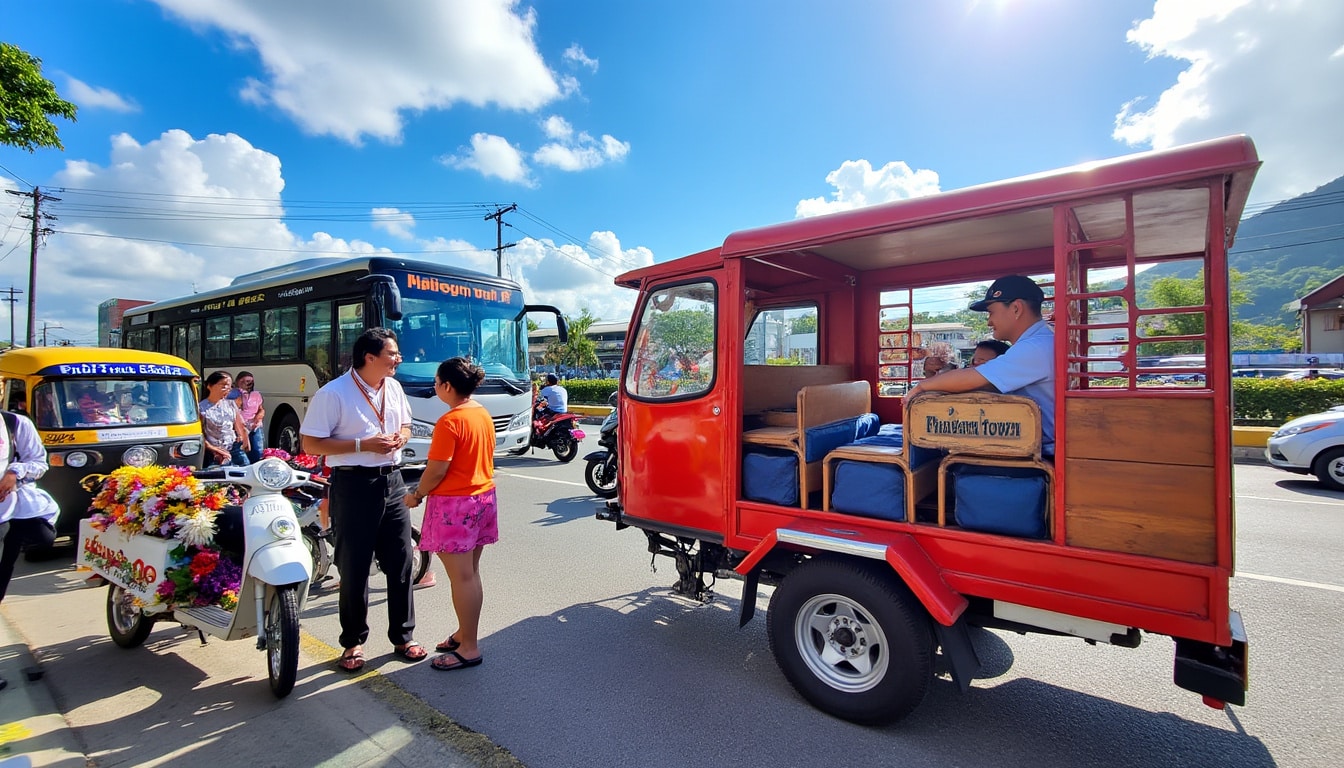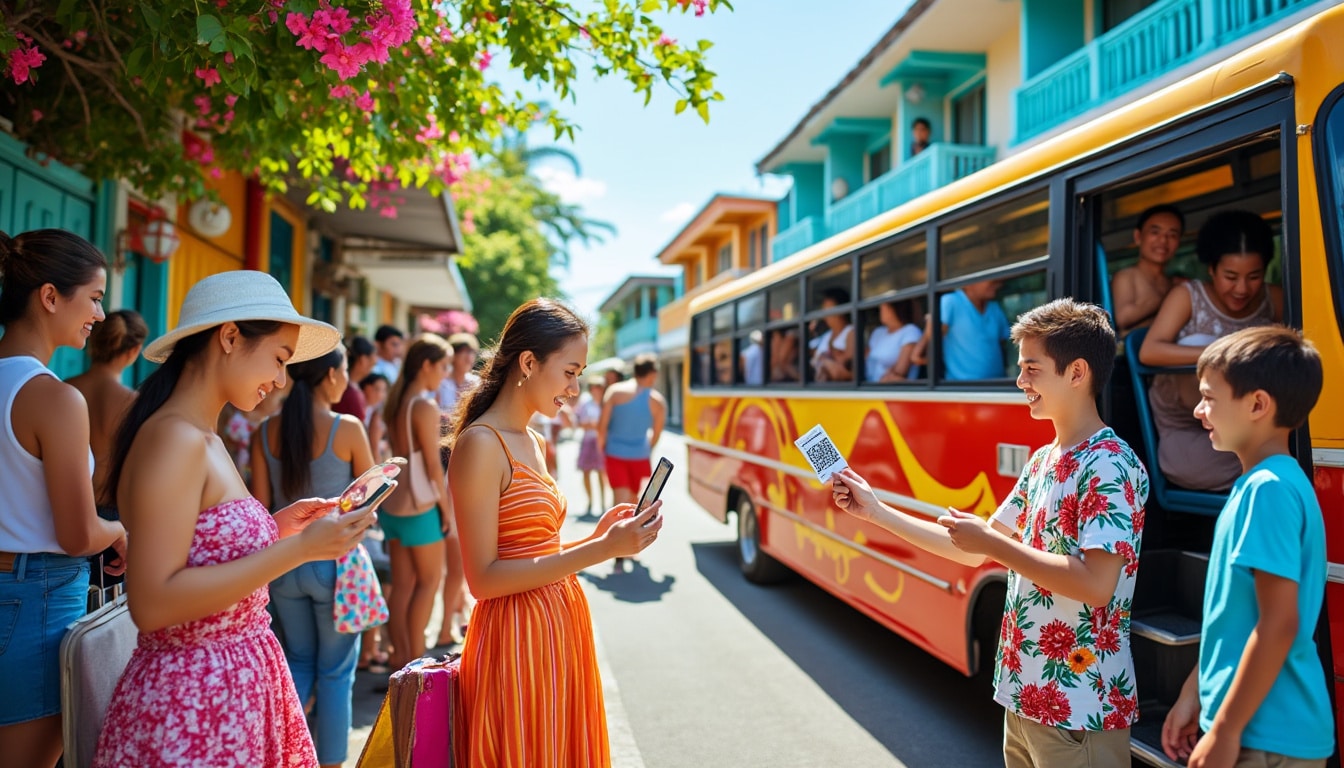Phuket, the jewel of Thailand’s islands, offers a vibrant mix of cultural experiences, stunning beaches, and bustling markets. As captivating as it is, navigating the island efficiently is crucial for both tourists and residents. Public transportation offers an accessible and economical way to explore the island, but understanding how to pay for these services can make a significant difference in your travel experience. From the Phuket Smart Bus to traditional blue buses, ride-sharing apps to taxis, each transport option provides a unique way to explore the island. In this guide, we will delve into the various ways of paying for public transport in Phuket, ensuring you can travel with ease and confidence.
Understanding Public Transport Options in Phuket
Phuket’s landscape is vast, covering an area of 576 square kilometers, and traversing the island can sometimes be challenging due to heavy traffic and narrow roads. However, a well-planned journey using public transport can ease the experience. Public transport in Phuket includes a mix of buses, songthaews (local blue buses), taxis, and ride-sharing services.
The Phuket Smart Bus is a convenient and affordable option for those wishing to travel between the island’s major locations. With a fixed route from Phuket International Airport to popular destinations like Patong, Karon, Kata, and Rawai, the Smart Bus offers a flat rate of 100 THB per journey for passengers over the age of seven. Payment can be made via cash or QR code, making it a straightforward choice for travelers.
Another option is the local blue bus, often referred to as songthaew. These buses are an adventurous way to explore Phuket, connecting Phuket Town with various beach towns. While there’s no specific timetable or official stops, these buses provide a local, budget-friendly experience. Payment is simply made in cash when boarding, typically ranging from 30 to 50 THB per ride. However, you should be prepared for a lack of air conditioning and a sometimes unpredictable schedule.
Tuk-tuks and taxis operate ubiquitously, with tuk-tuks being a more colorful and lively mode of transportation. Taxis come in different forms, such as red and yellow metered taxis or green plate taxis, where fares should be agreed upon upfront. These methods are more expensive but offer comfort and direct routes.
For tech-savvy travelers, ride-sharing apps like Grab and Bolt provide a modern alternative. Grab is widely used across Thailand and offers a reliable service with fare estimates provided before booking, reducing the risk of overcharging. Apps like Hello Phuket, Robinhood, AirAsia Super App, and others also offer similar functionalities.
Whether it’s a ride from your beachfront hotel to an authentic Thai market or a journey from the airport to your resort, understanding these options will empower you to take full advantage of what Phuket has to offer.

How to Pay: Cash, Cards, and Apps
Knowing the payment methods for each mode of public transportation in Phuket is essential to ensure a smooth journey. Most public transport options accept cash, but there are several other convenient ways to pay.
The Phuket Smart Bus allows payments through cash or the popular QR code system. The QR code payment can be managed via apps like Thai Ticket Major or Gojek, making it easier for both local and international travelers who prefer cashless transactions. Buying a public transport card is another effective option, allowing you to load money onto the card for multiple trips.
For songthaews, it’s a straightforward cash-only transaction. Travelers should carry small denominations to cover the fees. Additionally, having cash on hand is advisable when using tuk-tuks or taxis, especially for spontaneous rides. It’s always wise to agree on a price before beginning your journey to avoid any misunderstandings.
Ride-sharing apps like Grab and Bolt offer the convenience of pre-calculated fares and multiple payment options including card, PayPal, and sometimes cash. Ensure that your app is updated and that your preferred payment method is set before booking a ride.
- 🚌 Phuket Smart Bus – Cash or QR code
- 🚍 Songthaew – Cash only
- 🚖 Taxis and Tuk-tuks – Cash preferred, negotiate fare first
- 📱 Ride-sharing Apps (Grab, Bolt) – Card, PayPal, or cash
While modern technology and cashless options are becoming more prevalent, it’s prudent to have cash readily available, especially in more remote areas where network services can be spotty.
Comparing Transport Options: Pros and Cons
Choosing the right transport option in Phuket requires considering the pros and cons of each available method.
| Transport Mode | Pros | Cons |
|---|---|---|
| Phuket Smart Bus | Affordable, Air-conditioned | Fixed route, Potential delays |
| Songthaew (Blue Bus) | Budget-friendly, Local experience | No timetable, No aircon |
| Taxis/Tuk-tuks | Convenient, Direct routes | Expensive, Need to negotiate fares |
| Ride-sharing Apps | Fair pricing, Easy payments | Requires internet, App setup needed |
Whether prioritizing cost, convenience, or the cultural experience, there’s a transport solution to suit every traveler’s needs.
Practical Tips for Using Public Transport in Phuket
To maximize your transport experience in Phuket, consider these practical tips:
Firstly, ensure you have a local SIM card with a good data plan. This will not only help in finding routes via apps but also in enabling payments through QR codes. Exploring public transport options before your journey is advised; websites like Phuket Public Transport Guide provide a wealth of information.
When planning to use the Phuket Smart Bus, look for available maps showing bus stops and routes. While bus signs are often in English, having an offline map or a screenshot is handy. With songthaews, remember that exact change is appreciated, and drivers are typically friendly and accommodating.
Ridesharing apps offer seamless service but check upfront the preferred payment method. This saves time and avoids any last-minute scrambling for cash. At Phuket International Airport, Grab and Easy Taxi are accessible, providing a welcomed reprieve from the traditional taxi haggling.
For those considering longer stays in Phuket, renting a car might be a better option. This gives the freedom to explore more of the island at your own pace, as described in detail at Phuket Apartments Rentals.
Expectations When Using Public Transport in Phuket
Navigating public transport in Phuket as a newcomer can be thrilling and slightly overwhelming. First-timers should anticipate a mix of modern conveniences and traditional methods. The island atmosphere, while laid-back, doesn’t always translate to timely services, so patience is key.
Traditional transport like songthaews doesn’t adhere to strict schedules, providing a more spontaneous travel experience, whereas ride-sharing apps offer a sense of predictability and ease for the tech-savvy.
For tourists, using a combination of transportation modes can offer the best of both worlds. You can spend your day leisurely enjoying a bus ride down the coast and then take a quick Grab back to your accommodation at night.
Reading transport reviews from other travelers can be useful. Websites like Phuket Trip Costs & Budgeting provide insights into anticipated expenses and logistic expectations.
Finally, be open to improvising when necessary, as this adds to the authentic island adventure—a characteristic of travel within Phuket’s tropical charm.
Ride-Sharing and Taxis in Phuket
Ride-sharing apps and taxis are integral to Phuket’s transport landscape. These options present a flexible and personalized way to get around, especially useful for those unfamiliar with local transportation systems. In 2025, the primary ride-sharing options available include Grab, Bolt, and others, each app providing a user-friendly interface to book rides with multiple payment options.
When using a taxi, agreeing on a fare before beginning your journey is a crucial step to avoid being overcharged. While there are metered taxis, it’s common practice to negotiate a price for non-metered taxis.
- 🚖 Grab – Popular with easy fare estimates
- 🚖 Bolt – Often cheaper than Grab
- 🚖 Green Plate Taxis – Agreed fare upfront
- 🚖 Metered Taxis – Typically cheaper but sporadic availability
The Grab app, available on both Android and iOS, offers convenience, enabling users to compare fares between Grab and Bolt. The comparison can often result in savings and ensure that you’re receiving the best deal.
Social media platforms provide further tips and reviews from fellow travelers. Checking platforms such as Twitter for real-time updates and experiences can enhance your travel planning, allowing you to anticipate issues like delays or detours.
Before embarking on your journey to Phuket, equipping yourself with these insights ensures a smoother, more enjoyable travel experience.
Frequently Asked Questions
Q: What payment methods are commonly accepted for public transport in Phuket?
A: Cash is widely accepted, especially for songthaews and tuk-tuks. Grab allows for credit card payments, while the Phuket Smart Bus accepts QR code payments.
Q: Are ride-sharing apps expensive in Phuket?
A: They are generally reasonably priced, often cheaper than traditional taxis, and offer transparent pricing through the app.
Q: Can I use public transport to explore all parts of Phuket?
A: While public transport covers many areas, places off the main routes might require a combination of transport options or private hire.

